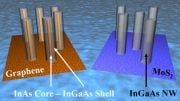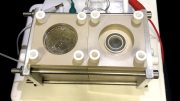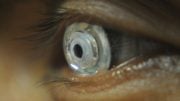
New research reveals possible applications of nickel, from data storage to biosensors.
When scientists and engineers discover new ways to optimize existing materials, it paves the way for innovations that make everything from our phones and computers to our medical equipment smaller, faster, and more efficient.
According to research published today (October 18, 2019) by Nature Journal NPG Asia Materials, a group of researchers — led by Edwin Fohtung, an associate professor of materials science and engineering at Rensselaer Polytechnic Institute — have found a new way to optimize nickel by unlocking properties that could enable numerous applications, from biosensors to quantum computing.
They demonstrated that when nickel is made into extremely small, single-crystal nanowires and subjected to mechanical energy, a huge magnetic field is produced, a phenomenon known as giant magnetostriction.
Inversely, if a magnetic field is applied to the material, then the atoms within will change shape. This displacement could be exploited to harvest energy. That characteristic, Fohtung said, is useful for data storage and data harvesting, even biosensors. Though nickel is a common material, its promise in these areas wasn’t previously known.
“Imagine building a system with large areas of nanowires. You could put it in an external magnetic field and it would harvest a very huge amount of mechanical energy, but it would be extremely small,” Fohtung said.
The researchers uncovered this unique property through a technique called lensless microscopy, in which a synchrotron is used to gather diffraction data. That data is then plugged into computer algorithms to produce 3D images of electronic density and atomic displacement.
Using a big data approach, Fohtung said, this technique can produce better images than traditional microscopes, giving researchers more information. It combines computational and experimental physics with materials science — an intersection of his multiple areas of expertise.
“This approach is capable of seeing extremely small objects and discovering things we never thought existed about these materials and their uses,” Fohtung said. “If you use lenses, there’s a limit to what you can see. It’s determined by the size of your lens, the nature of your lens, and the curvature of your lens. Without lenses, our resolution is limited by just the wavelength of the radiation.”
Fohtung used this same technique to show that barium hexaferrite — a universal and abundant material often used in tapes, CDs, and computer components — has spontaneous magnetic and electric polarization simultaneously that increases and decreases when exposed to an electric field. The property, known as ferroelectricity, is useful for fast-writing, power-saving, and data storage. Those findings were recently published in Physical Review B.
Fohtung believes that the lensless approach to studying substances will allow researchers to learn even more about solid state materials, like those used in technological devices. It may even enable a deeper understanding of human tissue and cells, which could be viewed in a more natural habitat using this technique.
“What excites me so much about it is the potential for the future. There are so many existing materials that we are just not able to understand the potential applications,” Fohtung said.
###
References:
- “Room temperature giant magnetostriction in single-crystal nickel nanowires” by Anastasios Pateras, Ross Harder, Sohini Manna, Boris Kiefer, Richard L. Sandberg, Stuart Trugman, Jong Woo Kim, Jose de la Venta, Eric E. Fullerton, Oleg G. Shpyrko and Edwin Fohtung, 18 October 2019, NPG Asia Materials.
DOI: 10.1038/s41427-019-0160-8 - “Nanoscale topological defects and improper ferroelectric domains in multiferroic barium hexaferrite nanocrystals” by D. Karpov, Z. Liu, A. Kumar, B. Kiefer, R. Harder, T. Lookman and E. Fohtung, 22 August 2019, Physical Review B.
DOI: 10.1103/PhysRevB.100.054432
Fohtung worked with researchers from Los Alamos National Laboratory, New Mexico State University, and Argonne National Laboratory on both publications.
About Rensselaer Polytechnic Institute
Founded in 1824, Rensselaer Polytechnic Institute is America’s first technological research university. Rensselaer encompasses five schools, 32 research centers, more than 145 academic programs, and a dynamic community made up of more than 7,900 students and over 100,000 living alumni. Rensselaer faculty and alumni include more than 145 National Academy members, six members of the National Inventors Hall of Fame, six National Medal of Technology winners, five National Medal of Science winners, and a Nobel Prize winner in Physics. With nearly 200 years of experience advancing scientific and technological knowledge, Rensselaer remains focused on addressing global challenges with a spirit of ingenuity and collaboration.









Be the first to comment on "Previously Unknown Capabilities of Common Materials Discovered by Big Data Analysis"